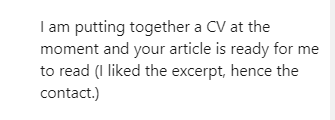How to write LinkedIn content that will win you business (or roles)
6 August 2019 By Victoria Tomlinson

I have been working with a lot of professionals recently on using LinkedIn to build new relationships that lead to business/roles. The next step is for them to start writing their own posts or longer articles (blogs) – but this is a terrifying step for many (even leaving out all the regulatory/compliance issues).
Here are my tips to start writing articles/blogs and take the fear out of the process.
1. What is the problem you are solving?
The best blogs on social media are those that help someone – so you want to start by thinking of questions that clients or contacts have asked you. It’s a rich source of what your market would find helpful and therefore help you in building relationships.
Someone contacted me this week – an executive chairman wanting help in getting another role and said

That is the response you are looking for – someone spots what you have written, reads it, saves it to be used and contacts you because your article shows you understand them and could help them.
2. The heading and first paragraph need to get attention
When I am helping people to blog, I always get them to imagine where and how people will be reading it.
The reality is it will probably be seen on someone’s phone amongst a plethora of emails, news alerts and other ‘noise’. They may be scrolling through first thing in the morning before leaving the house, squashed on a tube, waiting in a queue to buy a coffee or sitting in a pub waiting for a friend to arrive.
You have to get to the point quickly – what is the issue you are addressing, what is your blog about, and make it clear what people will get from it. The headline needs to grab them, the first paragraph needs to ensure they keep reading.
There needs to be a ‘so what’. In this particular blog, I have gone for how to write a post to win you business (or roles)’ – that is the problem I am solving.
3. Storytelling and real life examples
Theory is hard to understand or relate to. What everyone needs is a, ‘for example’. In this blog, I am doing several things to bring the points to life
- I started the blog talking about working with professional to help them with LinkedIn – and that they are terrified about posting. I am essentially positioning who this blog is written for and creating empathy – you are not alone in being terrified!
- I have given an example with the message extract to show you can get results from writing a post. I haven’t said who this person is, you can tell stories and give examples in an anonymous way
Use real life examples to make the point, it will help people understand the point you are making and be a more interesting read.
4. Structure the blog with helpful points
The best blogs guide you through easy steps to achieve something. How many times have you typed in a question on Google and found long, chatty articles that don’t answer your question. They may be interesting and have other purposes, but what people really love is the quick ‘how to’.
Numbering your points or having sub-headings is a good way to guide people through your advice.
5. Be generous
Years ago I wrote a blog on how to get senior people to your events. A couple of people commented that I had ‘given away our gold’, suggesting that by telling other people how to do this they won’t then buy this as a service.
The reality is, you can read the blog 50 times and few people will still have the skills or networks to get senior people to their events. If they can, well good luck to them. Generally, a blog like this is demonstrating your expertise and makes people want to come to you to help them.
Be generous in helping others, it’s a great way to do business. Include insights, tips, and your experience.
6. Blog length
There is no hard and fast rule about blog length. Minimum length tends to be around 600 words, maximum 1,000 if you have really good content. Some of this will depend on how engaging you are as a writer – the more helpful the content (and especially if packed full of examples), then the longer it can be.
7. Be vulnerable
The idea of being vulnerable is a really hard one for senior people to practice! Especially if you have been a professional used to being paid a lot of money for your advice – it is not instinctive to say, “that is an interesting point, I haven’t really formed a view on it yet”.
But you can still be professional and seen as an expert – but also ‘vulnerable’ and not having all the answers.
If you make a comment in a blog on the lines of, “The general view of xyz is … However in recent months I have seen a number of times that this isn’t working and starting to think we need to look at the problem in another way.” This sort of approach tends to create really good discussion and engagement – which is what you really want.
8. Write as if you are talking to someone
Blogs and social media generally, are conversations. You are aren’t writing the legal handbook on something, you are sharing your experience, ideas and tips. I always have someone in my mind that I am writing for and they ‘sit on my shoulder’. That helps me to write in a conversational way – but it also means I can hear them saying, “I don’t understand that”! So I go back and explain it better for them!
Those are my tips – and now I am going to be ‘vulnerable’. Before writing a blog I always do a quick Google search with the headline I have in mind to check out what is there, what the discussions are and what I can piggy-back. For this article I found a couple of blogs that would be useful for anyone really wanting to get discussions going online. I am going to recommend them and they have given me food for thought – but they are more for the advanced blogger/writer.
But for most people, I think the above tips will help you to take your first steps.
For further help, read my Amazon bestseller ‘How to Write a Top-Ranked Business Blog’ and talk to us if you want help writing your LinkedIn profile or using it to build relationships.


